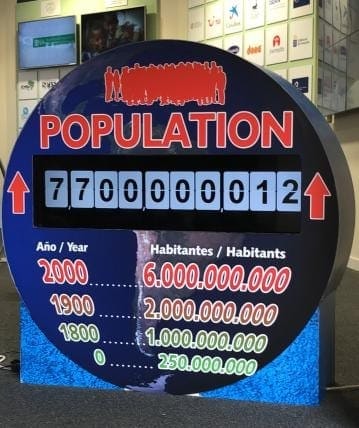Loro Parque’s World Population Clock, based on estimates by the United Nations’ Department of Economic and Social Affairs, has this week reached the historic figure of 7,7 billion people. According to this population growth trend, by 2023 there will be more than 8 billion people and 10 billion by 2056. Meaning that there are more and more inhabitants, but also more endangered species.
The Loro Parque Foundation warns that the enormous pressure of the growing population is driving animals out of their habitats. For example, it’s estimated that in Africa, before the Europeans arrived, there could have been over 29 million elephants. However, as early as 1935, the population had dropped to 10 million and now stands at less than 440,000, according to a 2012 study conducted by the International Union for Conservation of Nature.
This same scenario happened with the blue whales, whose population in Antarctica passed, in less than a century, from 340,000 to just over 1,000 specimens. Fortunately, thanks to international protection, the population of this species is slowly recovering. However, some cetaceans such as the Mexican Vaquita or Gulf porpoise have not been able to improve their numbers and are on the verge of extinction with less than 50 specimens registered.
At this point in time, United Nations estimates show that 57 per cent of the world’s population already lives in cities, far from contact with nature and animals. In addition, it’s estimated that by 2050 that percentage will have exceeded 80 per cent, making contact with nature even scarcer, with many people never having the opportunity to bond with wild animals.
Asia is the most populous continent on the planet, with 4,478 million people and a density of 144 people per square kilometre, followed by Africa with 1,246 million and Europe with 739 million. Population densities in Europe and the Americas do not exceed 30 people per square kilometre, yet the enormous amount of infrastructure and agricultural use have fragmented and reduced natural habitats.
This problem of overpopulation affects all individuals, as resource depletion, deforestation and pollution are just a sample of the consequences that affect everyone.
For this reason, the role of wildlife conservation centres such as Loro Parque is more important than ever – necessary to maintain living contact between animals and the public. Therefore, the mission of modern zoos is to fight to preserve endangered species, work to increase scientific knowledge about animal species to protect them, and seek to inspire love and protection of the animals in all their visitors. Thus, in an increasingly populated and urban world, zoos are the embassy of animals and nature.
WHAT TO TAKE AWAY FROM THIS ARTICLE:
- Therefore, the mission of modern zoos is to fight to preserve endangered species, work to increase scientific knowledge about animal species to protect them, and seek to inspire love and protection of the animals in all their visitors.
- However, as early as 1935, the population had dropped to 10 million and now stands at less than 440,000, according to a 2012 study conducted by the International Union for Conservation of Nature.
- Asia is the most populous continent on the planet, with 4,478 million people and a density of 144 people per square kilometre, followed by Africa with 1,246 million and Europe with 739 million.






















